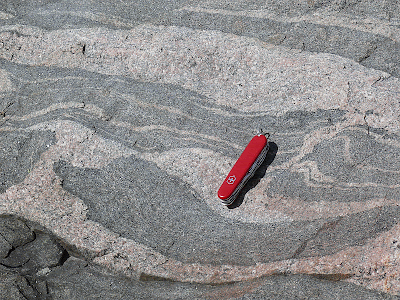The image below was taken during a field trip to the Adirondacks for my Geology of New York State course last spring. It's a well-known rock unit called the Popple Hill Gneiss.
Gneiss (pronounced "nice") is a high-grade metamorphic rock - this means it formed from a preexisting rock at very high temperatures and pressures. In this case, the preexisting rock was dacite - a type of silica-rich lava which once erupted from ancient volcanoes. Between 1.3 and 1.1 billion years ago, rocks of the Adirondacks (and the rocks under all of New York State for that matter), formed during a massive mountain building event called the Grenville Orogeny ("orogeny" is from the Greek words for "mountain" oros and "origins" genesis).
During mountain building, light-colored granitic magma was injected through fractures forming the pink rock seen above. After everything solidified, this entire unit was heavily folded and heated up high enough to remelt the quartz and feldspar (lowest melting points) of the igneous rock due to its being deep (over 12 miles down) in the core of the mountain belt.
This type of partially melted metamorphic rock, with its pretty swirling texture, is called a migmatite.
Here's a great wide-angle image of the entire outcrop along Route 58/812 near Hailsboro, NY.
Subscribe to:
Post Comments (Atom)



No comments:
Post a Comment